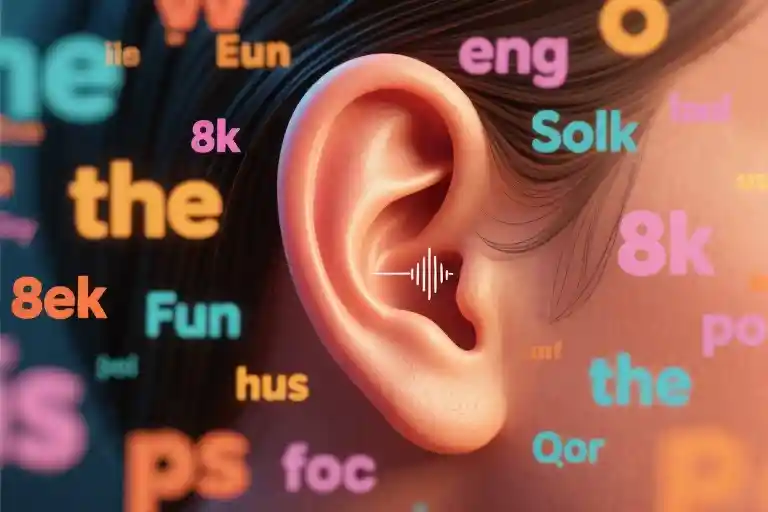The frustration is palpable when a student slumps back in their chair after listening practice, muttering those familiar words: “They were speaking way too fast—I didn’t catch anything!” As someone who’s sat on both sides of the language learning equation—first as a struggling learner, now as a teacher—I recognize that particular brand of defeat. That moment when native speech sounds less like communication and more like an impenetrable wall of noise.
We’ve all been there. You lean forward, shoulders tense, straining to decode what should be recognizable words. The harder you focus, the more the sounds blur together into meaningless babble. It’s enough to make you want to hurl your headphones across the room. The textbook dialogues you’ve mastered suddenly feel like childish simulations compared to this linguistic avalanche.
Here’s the uncomfortable truth: native speakers don’t talk fast—they talk normally. What we perceive as speed is simply natural speech flowing without the artificial pauses and exaggerated articulation of learning materials. The average English speaker delivers 150-160 words per minute in casual conversation, while most beginner listening exercises clock in at a glacial 90-100 words. That 60-word gap might as well be the Grand Canyon when you’re first bridging the divide between classroom English and the real world.
But speed alone isn’t the villain we make it out to be. When students claim “they’re speaking too fast,” they’re often describing a cluster of interconnected challenges: words blending together through linking sounds, vowels getting swallowed in casual speech, regional accents bending familiar vocabulary beyond recognition. These aren’t obstacles—they’re features of living language, the very elements that make speech fluid and efficient rather than robotic and disjointed.
The journey from “I can’t understand them” to “I can follow real conversations” requires rewiring how we process spoken language. It’s not about training natives to slow down (though we’ve all wished for that magic remote control). Rather, it’s about upgrading our listening operating system to handle natural speech inputs. This transition period—where authentic materials feel impossibly difficult—isn’t a failure. It’s the necessary friction that reshapes our ears and brains for genuine communication.
The Three Culprits Behind Your Listening Struggles
That moment when native speech sounds like a high-speed train rushing past your ears – we’ve all been there. The frustration isn’t just about speed, though that’s what most learners fixate on. After years of teaching and being a perpetual language student myself, I’ve identified three fundamental barriers that make natural speech so challenging to decode.
The Speed Illusion
Classroom recordings move at the dignified pace of a golf commentator, carefully enunciating each syllable. Real conversations? More like an auctioneer on espresso. The numbers don’t lie – while textbook audio averages 120 words per minute, spontaneous speech clocks in at 160-180 wpm for most English speakers. But here’s what surprises my students: when we artificially slow down authentic conversations, many still struggle. This reveals speed isn’t the true villain – it’s what happens to words at natural tempo.
Accent Roulette
During my first week in Glasgow, I genuinely thought locals were speaking Gaelic until I caught familiar words. That’s when I realized ‘accent’ isn’t just about pronouncing ‘tomato’ differently – it’s entire sound systems shifting. Indian English’s rhythmic cadence turns ‘development’ into three syllables instead of four. Australian vowels transform ‘today’ into ‘to die’. These systematic variations create what linguists call ‘accent filters’ – your brain keeps expecting one sound pattern while hearing another.
The Disappearing Act
Natural speech operates on linguistic economy – why say ‘going to’ when ‘gonna’ does the job? These shortcuts aren’t careless slurring but rule-bound transformations:
- Assimilation: ‘handbag’ becomes ‘hambag’
- Elision: ‘family’ loses its middle ‘i’
- Intrusion: ‘law and order’ grows a ‘r’ between words
What feels like ‘fast speech’ is actually highly efficient packaging. The problem? Most teaching materials unpack every parcel, leaving learners unprepared for reality’s wrapped gifts.
These three factors – tempo, variation, and transformation – form the holy trinity of listening comprehension challenges. The good news? Each can be systematically addressed, which we’ll explore in our next sections. For now, take comfort in knowing your struggles aren’t about lacking some magical ‘ear’ – you’re simply decoding a complex, living system that even natives occasionally mishear.
Key Concepts Demystified
Language learners often conflate two critical yet distinct concepts: pronunciation and accent. This confusion creates unnecessary roadblocks in their listening comprehension journey. Let’s unpack these terms with surgical precision.
Pronunciation: The Non-Negotiable Foundation
Pronunciation refers to producing speech sounds correctly within a language’s phonological system. When we say someone has “good pronunciation,” we mean they articulate words in a way native speakers recognize as accurate. The difference between “ship” and “sheep” isn’t stylistic – it’s phonemic, changing the word’s meaning entirely.
Try this diagnostic exercise:
- Listen to minimal pairs (words differing by one sound like “bit/bet” or “light/right”)
- Record yourself attempting these distinctions
- Compare your recordings to native speaker models
This isn’t about eliminating your native language influence, but ensuring your articulation falls within the target language’s acceptable range. A Spanish speaker might initially struggle with the English “v” vs. “b” distinction, while Japanese learners often merge “l” and “r” sounds. These aren’t accent issues – they’re pronunciation gaps that hinder communication.
Accent: The Flavor of Speech
Accent encompasses the distinctive way speech patterns manifest across regions and cultures. Unlike pronunciation errors that cause misunderstandings, accents represent valid variations within a language. Consider how:
- An Australian might say “dance” with a broader /æ/ sound than an American
- A Scot might roll the “r” in “girl” more prominently
- A Texan might diphthongize vowels differently than a Bostonian
These variations don’t indicate incorrect speech – they’re linguistic fingerprints revealing a speaker’s background. The key insight? You don’t need to eliminate your accent to be understood, but you must master pronunciation fundamentals.
The Global English Reality
English presents a unique challenge with its staggering accent diversity. The same sentence – “I’m going to the park after work” – transforms across dialects:
- Received Pronunciation (UK): crisp consonants, dropped /r/ in “park”
- General American: flapped /t/ in “after” sounds like “affer”
- Indian English: retroflex /t/ in “park,” syllable-timed rhythm
- Australian English: rising inflection, “after” becomes “aftah”
- Southern American: drawn-out vowels, “I’m” becomes “Ah’m”
- Scottish English: trilled /r/, shortened “going to” as “gonna”
This diversity explains why learners might understand their teacher perfectly but struggle with films or podcasts. It’s not that one accent is “better” – they’re simply different musical interpretations of the same linguistic score.
Bridging the Comprehension Gap
The path forward involves two parallel tracks:
- Solidify core pronunciation through targeted exercises (like those minimal pairs)
- Expand your accent exposure through curated listening materials
Start with one unfamiliar accent each month. Listen to short clips repeatedly until the patterns feel less foreign. Notice how speakers:
- Link words together
- Stress certain syllables
- Modify vowel sounds
Remember – your goal isn’t to mimic these accents (unless you want to), but to train your ear to decode them. Like a musician learning to identify instruments in an orchestra, you’re developing phonetic discernment.
This conceptual clarity transforms how you approach listening practice. Instead of frustration when encountering new accents, you’ll recognize them as variations on a theme rather than obstacles to comprehension.
The Three-Stage Training Method
Language learning isn’t about sudden breakthroughs – it’s about building skills layer by layer. When facing the challenge of understanding native speakers, we need systematic training that respects how our brains actually process speech. This three-stage approach has helped hundreds of my students transition from textbook comprehension to real-world listening.
Stage 1: Technological Assistance
Before diving into natural speech, we need to bridge the gap between classroom audio and reality. Technology becomes our training wheels here.
Variable-Speed Dictation begins with tools like Audacity. The process is simple but powerful:
- Select a short audio clip (30 seconds max) from authentic material like podcasts
- Slow it down to 0.7x speed while maintaining pitch
- Write down every word you hear
- Compare with the transcript, marking problem areas
- Gradually increase speed over weeks
What makes this effective isn’t just the slowing down – it’s the systematic speed progression that trains your brain to process faster speech without overwhelming it.
Speech Visualization takes this further with tools like Praat. Seeing sound waves makes abstract concepts concrete:
- Visualizing how “I have to” becomes “I hafta” in connected speech
- Comparing your pronunciation spectrograms with native samples
- Identifying which phonemes you consistently mishear
One student discovered she couldn’t distinguish /æ/ and /ɛ/ sounds until seeing their different frequency patterns. Three weeks of spectral analysis practice fixed this lifelong listening gap.
Stage 2: Shadowing Technique
Now we move from passive reception to active production with shadowing – the gold standard for developing listening reflexes. The method seems deceptively simple: listen and simultaneously repeat what you hear with minimal delay.
Start with slowed-down audio (0.5x speed) of clear speakers like BBC newsreaders. Focus on:
- Precision: Matching the speaker’s rhythm exactly, even if it means pausing frequently
- Articulation: Feeling how your mouth shapes unfamiliar sounds
- Flow: Gradually reducing the delay between hearing and speaking
As comfort grows, increase speed in 0.1 increments until you can shadow at 1.2x normal speed. This overtraining creates “processing headroom” – making natural speech feel slower by comparison.
Stage 3: Real-World Application
The final stage removes all training wheels. Select materials that genuinely interest you – TED Talks, YouTube vloggers, or movie scenes. Two techniques make this manageable:
The IMDb Method for films/series:
- Watch a scene without subtitles
- Check the script for problematic sections
- Isolate and loop difficult phrases
- Re-watch until you hear what you’ve studied
The 80/20 Approach for podcasts/lectures:
- First pass: Just track the main ideas
- Second pass: Note supporting arguments
- Third pass: Focus on connective phrases
- Only then check the transcript
This staged engagement prevents frustration while training top-down processing – learning to comprehend without needing every word.
Remember, progress isn’t linear. Some days your brain will feel like it’s regressing – this is actually consolidation at work. Track your improvements monthly rather than daily, and you’ll be amazed at how natural speech gradually transforms from noise to meaning.
Resource Toolbox
Having the right tools can make all the difference in your listening comprehension journey. Here’s a carefully curated selection of resources that have helped my students bridge the gap between classroom English and real-world conversations.
Speed Control Essentials
When starting out, being able to adjust playback speed is crucial. Audacity remains my top recommendation – this free, open-source audio software lets you slow down recordings without distorting voices. For mobile users, the YouTube speed control feature (available on most browsers) works surprisingly well for casual practice. Podcast enthusiasts should try Overcast (iOS) or Podcast Addict (Android), both offering variable speed playback.
Seeing Speech Patterns
Sometimes you need to visualize what your ears can’t catch. Praat, while initially intimidating, provides spectacular spectrogram views showing exactly where sounds get swallowed in connected speech. For a more user-friendly option, Speechling’s pronunciation analyzer gives instant feedback by comparing your recordings to native speaker models.
Smart Subtitles
Transitioning from subtitles to no subtitles requires strategy. Language Reactor (formerly Language Learning with Netflix) lets you toggle between English and target language subtitles while saving vocabulary. For YouTube, check out the ‘Dual Subtitles’ extension that displays two languages simultaneously – perfect for noticing how spoken words differ from their written forms.
Graded Listening Materials
Building comprehension works best with materials matching your current level:
Beginner (A1-A2):
- Coffee Break English (scripted dialogues with explanations)
- BBC Learning English ‘The English We Speak’ (3-minute idiom explanations)
Intermediate (B1-B2):
- 6 Minute English (BBC discussion show with transcripts)
- Easy Stories in English (graded fairy tales retold)
Advanced (C1+):
- The Daily (NY Times news analysis)
- No Such Thing As A Fish (fast-paced British comedy factshow)
Remember, effective listening practice isn’t about finding ‘perfect’ resources – it’s about using imperfect real-world materials strategically. Start where you are, use what you have, and let these tools help you decode the beautiful chaos of natural speech.
Common Questions About Listening Comprehension
The journey to understanding native speakers often leaves language learners with persistent questions. Two of the most frequent frustrations I hear in my teaching practice deserve special attention, as they reveal fundamental misunderstandings about how listening comprehension works.
Why Can I Understand Slow Speech But Not Natural Speed?
This universal struggle stems from how our brains process unfamiliar sounds. When you listen to artificially slowed audio, your working memory has time to analyze each phoneme individually. But natural speech doesn’t come with convenient pauses between words – it arrives as a continuous stream where sounds blend and transform through connected speech patterns.
Cognitive load theory explains this perfectly. Your brain has limited processing capacity for unfamiliar linguistic input. At slow speeds, you’re operating comfortably within your cognitive bandwidth. But when confronted with natural pace speech containing features like liaison (“not at all” becoming “noda-tall”) and elision (“government” sounding like “gov’ment”), your mental resources get overwhelmed. The solution isn’t more slow listening – it’s progressive exposure. Start with slowed audio where you comprehend 70-80%, then gradually increase speed while maintaining that comprehension threshold. Tools like Audacity’s tempo-preserving speed adjustment or YouTube’s playback controls make this training method accessible.
Should I Mimic Native Speaker Accents?
This question divides language learners, but the answer becomes clear when we distinguish between pronunciation and accent. Pronunciation refers to producing sounds correctly enough to be understood – saying “three” clearly enough that it doesn’t sound like “tree.” Accent involves adopting the musicality and regional characteristics of speech – whether you roll your R’s like a Scot or flatten them like a Californian.
For listening comprehension purposes, developing accent awareness matters more than imitation. Familiarize yourself with major accent variations through curated resources like the International Dialects of English Archive. When my students ask about mimicking accents, I advise focusing first on comprehension through active listening exercises. Once you can reliably distinguish between “can” (ability) and “can’t” (inability) in fast speech – regardless of accent – you’ve built functional listening skills. The exception comes if you’re preparing for specific contexts like acting or diplomatic work where accent precision becomes professionally relevant.
These questions highlight a deeper truth about language acquisition: listening isn’t passive reception but active interpretation. The frustrations you experience aren’t failures – they’re signposts showing where your brain is restructuring itself to handle this complex skill. Every time you struggle to parse fast speech or identify an unfamiliar accent variation, you’re building the neural pathways that will eventually make comprehension effortless.
The Journey Ahead Starts Today
We’ve walked through the storm of frustration together – dissected why native speakers sound like hummingbirds on caffeine, untangled the knotty differences between accents and pronunciation, and mapped out a clear three-stage training plan. Now comes the simplest yet most profound step: beginning.
Your first mission – should you choose to accept it – requires just ten minutes today. Find a short audio clip (maybe that TED Talk you abandoned last week), slow it down to 0.75x speed, and shadow the speaker like a linguistic stalker. Mimic not just words but their musicality – the rises, falls, and pauses. When you stumble, rewind like you’re teaching a golden retriever to fetch. This isn’t failure; it’s your brain creating new neural pathways.
Remember Krashen’s i+1 principle – that magical spot just beyond your current level. It’s why toddlers don’t start with Shakespeare. Your listening materials should feel like stretching for a book on the top shelf: fingertips brushing the spine, not straining for something three aisles away. Tomorrow’s 0.8x speed is today’s +1.
Now I’m passing the microphone. What was your most humbling listening moment? The time an airport announcement made you board the wrong plane? When “How’s it going?” sounded like ancient Aramaic? Share your stories below – let’s turn those facepalm moments into stepping stones. Every expert was once a beginner who showed up day after frustrating day.
The road to comprehension isn’t paved with perfection, but with patience and playful curiosity. Six months from now, when you catch yourself laughing at a podcast joke or following a rapid-fire debate, you’ll look back at today as the turning point. Ready to press play on your progress?





